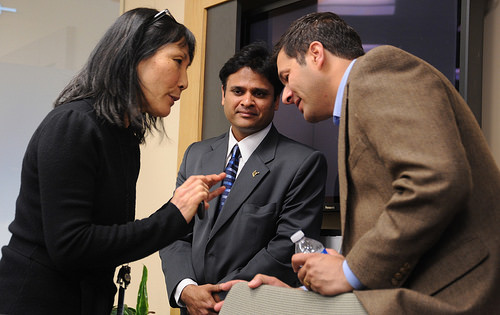
How middle managers can boost employee engagement and customer experience
February 9, 2017
The implosion of trust and what to do about it
February 15, 2017Co-creation, innovation and when you should get your customers involved – Interview with Prof. Jan van den Ende
Today’s interview is with Professor Jan van den Ende, who is Professor of Management of Technology and Innovation at RSM (Rotterdam School of Management), Erasmus University, Rotterdam. Jan joins me today to talk about a research paper that he and some colleagues recently published and how ignoring customers’ opinions can lead to more successful products.
This interview follows on from my recent interview – Behavioural insights and what is really going on in the minds of your customers – Interview with Dr. Simon Moore of Innovationbubble – and is number 204 in the series of interviews with authors and business leaders that are doing great things, providing valuable insights, helping businesses innovate and delivering great service and experience to both their customers and their employees.
Here’s the highlights of my interview with Jan:
-
- Collaborating with customers, co-creating new products and services and open innovation is very fashionable at the moment.
- However, despite that, Steve Jobs was famously quoted as saying “You can’t just ask customers what they want and then try to give that to them. By the time you get it built, they’ll want something new.”
- As a result, there is some debate around the overall usefulness of involving customers in the innovation process.
- Jan along with academic colleagues, Marina Candi and Gerda Gemser, were intrigued by this and suspected that the value of the customer’s input may depend on the type of innovation involved.
- To test this idea they studied 132 recent innovation projects by Dutch firms.
- The results of their study have recently been published in a paper:
- Candi, M, Van den Ende, J. & Gemser, G. (2015). Benefits of Customer Codevelopment of New Products: The Moderating Effects of Utilitarian and Hedonic Radicalness. Journal of Product Innovation Management.
- The full version of the paper can be found here).
- In the study they differentiated between utilitarian innovations (i.e. those that create new functionality or involve new/improved technology) and hedonic innovations (i.e. those that are designed to evoke a sensory or emotional experience or that have a large degree of a personal identity/expression attached to them).
- Jan provides a couple of examples to illustrate the difference:
- The electric bikes that are now available to hire in the Netherlands are clearly an utilitarian innovation as they help you get a bit about faster and a little easier, especially in windy conditions.
- Jan recounts a story of when he spoke to a Marketing Manager at BMW who told him that there are three reasons that people buy a car: 1. Does it look cool? 2. Is it safe? and 3. Do I look cool in it? Clearly, two out of the three reasons are hedonic in nature.
- In their study, they found that involving customers in a product/service development process is a good idea when the innovations are utilitarian in nature and, in particular, when the innovations are more radical in nature.
- When firms do this it tends to lead to greater market success.
- However, involving customers in the product development process for hedonic innovations can actually decrease the chances of market success.
- This, they conclude, is due to the social process/dynamics that exist around such innovations (i.e. what do people think, are other people doing/wearing this, what does this say about me etc).
- Jan’s advice:
- If your innovation is going to be utilitarian in nature then get your customers involved, ask their opinion, ask them what new features or functionality they would like to see; and
- If your innovation is likely to be more hedonic in nature then don’t get your customers involved, be design led, build some prototypes and test them out to see if they will work or not. In addition, when it comes to hedonic innovations, you could consider implementing appropriate marketing strategies (endorsements etc) that will help manage the social process/dynamics mentioned earlier.
- Companies should organise their innovation activity better.
- They should also distinguish between more incremental and radical innovations more.
- Incremental innovations can follow a more structured process whilst more radical innovations will need a more flexible approach.
- A wow product is normally associated with something that is very high-end/expensive. However, Jan is also a fan of and considers disruptive products as delivering a business wow.
- Do check out the free course on Innovation Management that Jan and his group at RSM have developed and put on Coursera. You can access it and take it for free here.
About Jan (taken from his university bio)
Jan van den Ende is a professor of management of technology and innovation at Rotterdam School of Management, Erasmus University (RSM) and holds the International Chair of Management, LUISS Universita Guido Carli, Rome, Italy.
His field of expertise is the development process of new products and services in firms. His current research interests include firm-internal and -external idea management, control of NPD projects, design management and sustainable innovation.
Jan van den Ende has published in numerous journals including Journal of Management Studies, Organization Studies, Harvard Business Review, Journal of Product Innovation Management, Research Policy, IEEE Transactions on Engineering Management, and Group and Organization Management.
He teaches in MBA and Executive Education for firms such as ASML, FrieslandCampina, IFF and MAN. Van den Ende holds a PhD from Delft University of Technology.
You can find Jan’s contact details here and can connect with him on LinkedIn here.





3 Comments
An interesting observation Adrian.
In the dim and distant past I was a R&D manager for a well known frozen food company.
The question I have is is a beef burger hedonic or utilitarian?
Thank you, James.
On the beef burger question, would it not depend on how hungry you were?